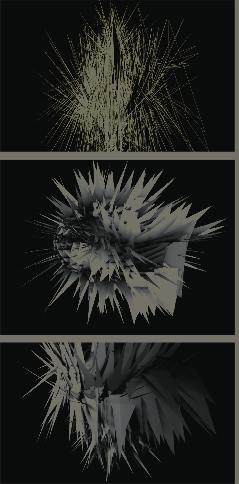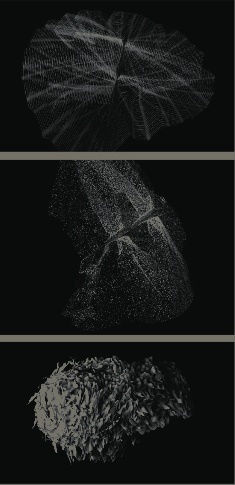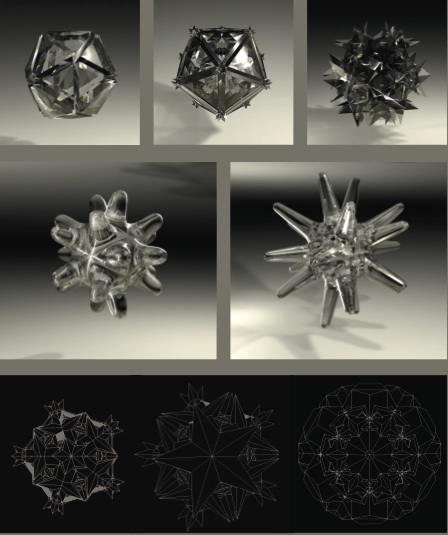Injecting Life-Sound
One of the basic premises of my concept is that in order to create a-life there needs to be a guiding force that moves these virtual organisms – essentially their energy or dare I say, soul. Without dwelling too much in metaphysical debates, I felt that this force should be external to the system, like divine inspiration the life energy is injected from a godly figure outside the system that moves these otherwise inanimate objects. The life force itself should be constant but evolutionary at the same time, in other words it should be a continuous flow of energy that continuously changes bringing about evolution into the system. In digital terms I needed a stream of data that randomly changes over time that could be translated into movements and reactions within the system. Sound was the obvious choice as it can be easily used as raw data that can be translated into other forms of explication. Sound also has the advantage of being easily recognised by an observer as a source of information, is evolutionary as it changes over time and can become a living process itself. In fact there is a genre called evolutionary music which uses the principles of mathematical algorithms and biological processes to create "living" music.


I began with the simple concept of generating a sphere within Cinema4d and making it react to sound (above). What the program does it to analyse the sound according to frequency which can be described as a two dimensional chart with the x axis the amount of hertz (eg. from 0 to 44,100hz) and the y axis the amplitude (from -6 to 6). The frequency is then multiplied or divided according to the number of assignments, for example if you assign the sound to the 8 points of a cube, the program divides the frequency into 8 parts and finds the average. The effector itself has a myriad of different parameters and this is where things get complicated. In these early experiments the parameters altered were mainly those of displacement. The result of these initial experiments were quite abstract non-sensical and quite crude objects that really did not refer back to the sound that created them. The capability of the sound effector showed great potential for further expansion and experimentation though.
Platonic Deformations
In the following experiments I tried a more controlled approach, in order to get a less abstract and more geometric result. The base objects used were platonic solids such as tetrahedrons, octahedrons, dodecahedrons etc. An extrusion effector was applied to each of their sides and sound frequency was applied to the extrusion effector. The result was that when the sound would get louder, each side would extrude higher. Some of the results were quite predictable such as the ones in the middle row here where the shapes produced were simple stars with each “ray” of equal length. The more interesting results were the ones of the first row where the polygons would overlap creating interesting shapes. I went on to render them with a cel renderer (bottom row) to examine the geometry of these objects. In terms of life-forms these weren't biological as such but looked more like atomic or crystalline structures. This made me realise that "life" is not necessarily a biological process, (although strictly speaking life is defined by the known golden rules (reproduction, growth, metabolism etc.) but can be perhaps abstracted from various mediums as an evolutionary process.
I went on to the other extreme to create subtle liquid-like objects that react to sound. In the first example (video) the objects reacts by exuding an array of droplets that vibrate and take shape according to the sound. The purpose of this was to simulate a living cell interacting with its environment similar to how amoebas for example extend pseudopodia to move or ingest nutrients. In the second example (video) the effect of sound is more subtle making the object vibrate and create ripples as if it is perceiving the sound in some way.

Here I continued with experimenting on using sound to create more organic results. This is where I started looking at organic texturing using mathematically calculated fractals known as shaders. As these shaders are based on evolutionary algorithms they too can be considered as descriptors of a-life. In this video the actual material of the object reacts quite abrubtly to sound creating cavities within it.

In the experiments above I tried to create a texture that looked like muscle fibres, trying to get a hang of complex texturing. As you can see on the far left the object is created by an array of spheres that are positioned spherically according to sound frequency. These are then wrapped within a metaball that essentially creates a fluid skin around them. The result (far right) remains quite abstract but is starting to look more realistically organic.
